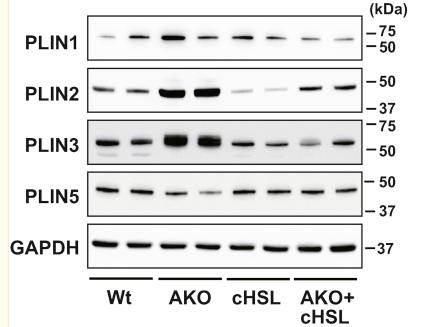Phospho-Perilipin-1 (Ser522) Antibody - #AF3834
| Product: | Phospho-Perilipin-1 (Ser522) Antibody |
| Catalog: | AF3834 |
| Description: | Rabbit polyclonal antibody to Phospho-Perilipin-1 (Ser522) |
| Application: | IHC |
| Cited expt.: | |
| Reactivity: | Human, Mouse, Rat |
| Mol.Wt.: | 56kD(Calculated). |
| Uniprot: | O60240 |
| RRID: | AB_2847148 |
Product Info
*The optimal dilutions should be determined by the end user. For optimal experimental results, antibody reuse is not recommended.
*Tips:
WB: For western blot detection of denatured protein samples. IHC: For immunohistochemical detection of paraffin sections (IHC-p) or frozen sections (IHC-f) of tissue samples. IF/ICC: For immunofluorescence detection of cell samples. ELISA(peptide): For ELISA detection of antigenic peptide.
Cite Format: Affinity Biosciences Cat# AF3834, RRID:AB_2847148.
Fold/Unfold
Lipid droplet associated protein; Lipid droplet-associated protein; PERI; Perilipin A; Perilipin; Perilipin-1; PerilipinA; PLIN; PLIN1; PLIN1_HUMAN;
Immunogens
A synthesized peptide derived from human Perilipin-1 around the phosphorylation site of Ser522.
Detected in adipocytes from white adipose tissue (at protein level) (PubMed:27832861). Detected in visceral adipose tissue and mammary gland (PubMed:9521880).
- O60240 PLIN1_HUMAN:
- Protein BLAST With
- NCBI/
- ExPASy/
- Uniprot
MAVNKGLTLLDGDLPEQENVLQRVLQLPVVSGTCECFQKTYTSTKEAHPLVASVCNAYEKGVQSASSLAAWSMEPVVRRLSTQFTAANELACRGLDHLEEKIPALQYPPEKIASELKDTISTRLRSARNSISVPIASTSDKVLGAALAGCELAWGVARDTAEFAANTRAGRLASGGADLALGSIEKVVEYLLPPDKEESAPAPGHQQAQKSPKAKPSLLSRVGALTNTLSRYTVQTMARALEQGHTVAMWIPGVVPLSSLAQWGASVAMQAVSRRRSEVRVPWLHSLAAAQEEDHEDQTDTEGEDTEEEEELETEENKFSEVAALPGPRGLLGGVAHTLQKTLQTTISAVTWAPAAVLGMAGRVLHLTPAPAVSSTKGRAMSLSDALKGVTDNVVDTVVHYVPLPRLSLMEPESEFRDIDNPPAEVERREAERRASGAPSAGPEPAPRLAQPRRSLRSAQSPGAPPGPGLEDEVATPAAPRPGFPAVPREKPKRRVSDSFFRPSVMEPILGRTHYSQLRKKS
Research Backgrounds
Modulator of adipocyte lipid metabolism. Coats lipid storage droplets to protect them from breakdown by hormone-sensitive lipase (HSL). Its absence may result in leanness. Plays a role in unilocular lipid droplet formation by activating CIDEC. Their interaction promotes lipid droplet enlargement and directional net neutral lipid transfer. May modulate lipolysis and triglyceride levels.
Major cAMP-dependent protein kinase-substrate in adipocytes, also dephosphorylated by PP1. When phosphorylated, may be maximally sensitive to HSL and when unphosphorylated, may play a role in the inhibition of lipolysis, by acting as a barrier in lipid droplet (By similarity).
Endoplasmic reticulum. Lipid droplet.
Note: Lipid droplet surface-associated.
Detected in adipocytes from white adipose tissue (at protein level). Detected in visceral adipose tissue and mammary gland.
Belongs to the perilipin family.
Research Fields
· Environmental Information Processing > Signal transduction > Apelin signaling pathway. (View pathway)
· Organismal Systems > Endocrine system > PPAR signaling pathway.
· Organismal Systems > Endocrine system > Regulation of lipolysis in adipocytes.
References
Application: WB Species: Mice Sample: cardiac tissues
Restrictive clause
Affinity Biosciences tests all products strictly. Citations are provided as a resource for additional applications that have not been validated by Affinity Biosciences. Please choose the appropriate format for each application and consult Materials and Methods sections for additional details about the use of any product in these publications.
For Research Use Only.
Not for use in diagnostic or therapeutic procedures. Not for resale. Not for distribution without written consent. Affinity Biosciences will not be held responsible for patent infringement or other violations that may occur with the use of our products. Affinity Biosciences, Affinity Biosciences Logo and all other trademarks are the property of Affinity Biosciences LTD.


